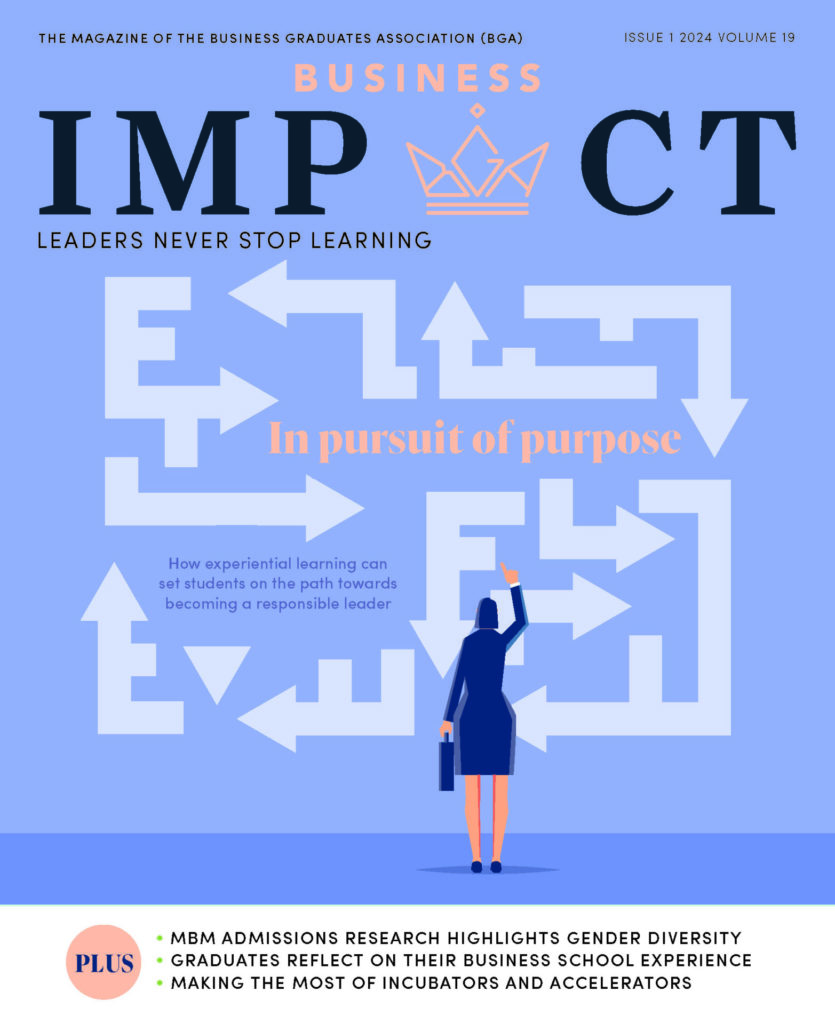Imagine being offered the opportunity to engage over nine consecutive weeks with a small group of individuals who share feedback directly and in real time with you on how you show up and how your behaviours impact them. Sounds a bit scary, right? Well, 96 MBA students every quarter at Chicago Booth (12 students per section) lean steadily into that fear. They gain valuable benefits in a newly established leadership course offered through the Harry L Davis Centre for Leadership at Booth called Interpersonal Dynamics.
In an MBA programme known for its economics and finance classes taught by many Nobel prize winners, the Interpersonal Dynamics course is holding its own in popularity among the students. More than 200 students apply each quarter in the hopes of gaining a coveted spot in the class. It’s one of a few leadership courses at Booth aimed at creating a balance among these emerging leaders, with the school developing its reputation for building the people leadership capabilities of students alongside the hard quant skills for which Booth has long been famous.
An experiment gone right
Interpersonal Dynamics started as an experiment at Booth in the autumn quarter of 2019, with just two sections of 12 students. Demand for the class rose so sharply that in just three short years, two sections grew to eight sections and by autumn 2023, we will have up to 10 sections offered each quarter. To teach the course, Booth has three full-time clinical professors: Christine Carpenter, Darryl Pure and myself. There are also three adjunct professors: Hugh Cole, Britt Raphling and Rick Volden. Together, we represent the collaboration between leadership, team and organisational effectiveness, as well as the discipline of psychotherapy.
My personal story in this co-created course began in the autumn of 2007 when I started my MBA at Booth. I chose Booth and its rigorous quant reputation to complement an already robust background in leadership and team effectiveness. My classmates were brilliant in economics and finance, but many lacked strength in interpersonal and leadership skillsets. I began to have regular conversations with Booth’s leadership, first as a student and then later as a concerned alumna. I was thrilled when behavioural finance professor Rob Vishny took over the leadership of the Harry L Davis Centre for Leadership at Chicago Booth. He held his own vision to introduce Interpersonal Dynamics and other leadership courses at Booth.
Room for experimentation
During the course, each professor is joined by a co-facilitator to support a well-proven learning methodology called ‘T-Group’ or ‘Training Group’, which was developed by the NTL Institute for Applied Behavioural Science more than 70 years ago. T-Group is a here-and-now process that is purposefully devoid of a pre-determined agenda, structure or leader. T-Group is used across many MBA programmes, most notably at Stanford Graduate School of Business which pioneered the process in its own interpersonal dynamics course that has been going strong since 1968.
The learning is personalised, as each student arrives to the first day of class with a set of learning goals specific to them. Throughout the quarter, students are given opportunities to experiment with new behaviours and receive immediate feedback from their peers. This allows students to enquire in real time about the behaviours they see, as well as to discover where they stem from and why that matters.
Some examples of learning goals include “be honest with others when overwhelmed and be able to ask for support or help” and “become more comfortable receiving positive feedback.” We feel inspired every single quarter by the rich content our Booth students create for themselves and with one another.
Sustaining and strengthening relationships
If we were to sum up in one sentence what the course offers students at Chicago Booth, it would be this: “Interpersonal Dynamics teaches our future business leaders to know how to effectively give and receive feedback in a way that sustains if not strengthens relationship.”
Achieving the above is uncomfortable and time-consuming work through intention and failure, repetition and repair. Learning how to give and receive feedback and how to connect across difference are courageous and often uncomfortable experiences.
An example may help us put this into context. In one of my classes, a woman chose to give feedback to her male classmate who often arrived to class a few minutes late. She nervously shared many qualifiers and accolades, never getting to her actual feedback. The gentleman thanked her hesitantly and looked distraught in the interaction. The discomfort was rising and I saw an opportunity to support growth in both of them so I stepped in and encouraged the woman to name her direct feedback. She then said, “When you arrive late, I feel distracted and frustrated. I make up a story that you don’t care about this class.”
Sharing in this way touched on two of her learning goals for the quarter: to be more direct in her communication and to improve her ability to give difficult feedback. Once she was able to name the direct impact of his behaviour on her, the other student visibly relaxed and even thanked her for taking the risk to give him feedback. By the end of their exchange, it was clear their relationship had improved, and the male student had made a commitment to arrive on time from then on.
Comfort in uncomfortable
The above anecdote leads us to share a second sentence that could also sum up the class: “Students learn to become more comfortable with being uncomfortable.” This antifragility in the face of fear and other strong feelings in the midst of imposter syndrome, self-limiting beliefs, mental models and assumptions is among the strongest footholds we have found and witnessed in effective leadership. We want our students to learn how to be comfortable with being uncomfortable; and giving and receiving feedback is both necessary and hard to do.
This is the first of a two-part series. Learn more about the Interpersonal Dynamics course and approach to leadership taken at Chicago Booth in the second part of this article.
Headline image credit: Niklas Ohlrogge on Unsplash









